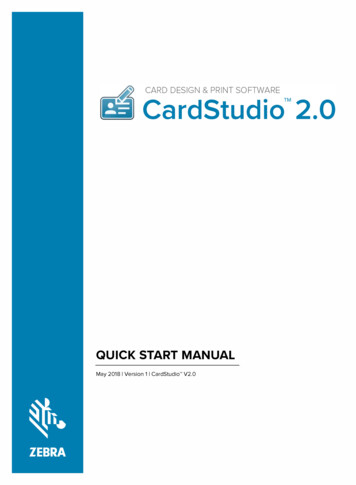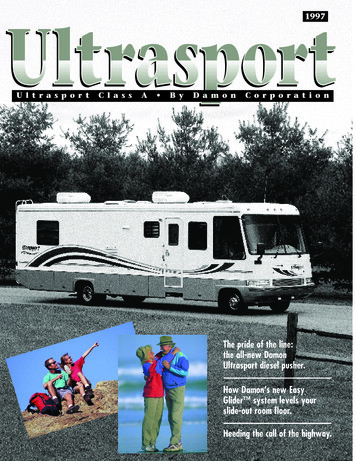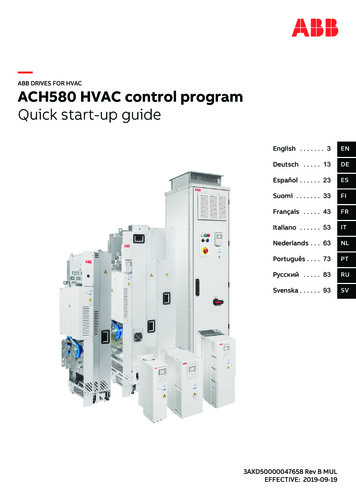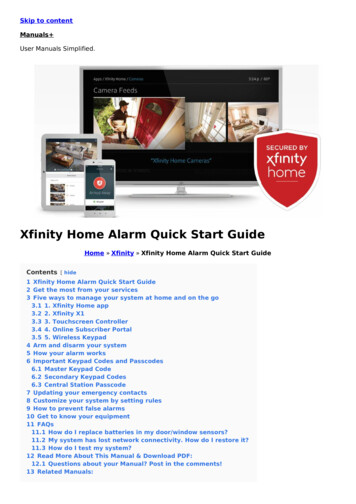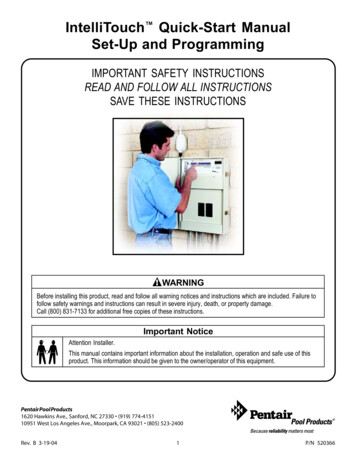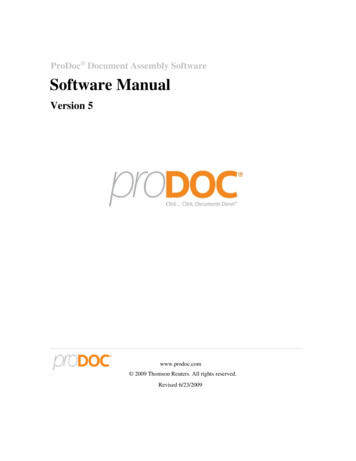
Transcription
Quick Start GuideIncludes tips on: Bonding Wire selection and sequencing Wire placement Archwire stops Troubleshooting GuideWritten and edited by Dr. Dwight Damon and Dr. Alan Bagden.
Bonding Technique with Blūgloolightly,2
Bonding Day and First Recall Appointment TipsBonding DayTooth Preparation Etch each tooth 30 seconds (one arch at a time)*. Rinse thoroughly for a minimum of 5 seconds per tooth. Dry the etched enamel with clean, oil-free, dry air.*or per manufacturers recommendationBond Upper/Lower 7 to 7 (No more bands) Apply thin coat of Ortho Solo to all teeth. Extrude small amount of blūgloo adhesive onto the base of the bracket pad. For best results, “butter” adhesive into the base of the bracket pad. Place, position, press lightly to express adhesive and remove excess. Finalize position and begin light curing within 1 minute. Light cure as per manufactures recommendationFirst Archwire Always use .014 Damon Copper Ni-Ti on U/L arches (.013 Damon Copper Ni-Ti forextremely crowded cases). Crimp preloaded stops anterior to the crowding. Cut both archwires distal to the 6s to minimize wire poking.Deep-Bite Cases If lower anterior brackets are likely to be in occlusion, use Bite Turbos, posterior compositebuildups, or bond lowers at next appointment.Leave NO teeth behind. Bond half-brackets to partially blocked-out teeth.10-week appointment intervals during the first phase of treatment.To allow posterior arch development, do not use any appliance that will bind the molarstogether, such as RPEs, TPAs, or Headgear.First Recall Appointment (minimum of 10 weeks out) Remove archwires.Check for permanent deformations and replace with new archwire if necessary.Have patient brush and rinse.Insert original or new archwire as indicated.3
Wire Selection & Sequence*.019**.016 x .025 isfrequently used.4
Wire Placement TechniquesTo close Damon brackets, the archwire must be inserted into the slot so that it is not obstructing theslide. Ordinarily, archwires can be inserted with the fingertips and the slides will close easily, either with afinger (Damon3) or with a Damon Universal Plier (Damon2). Here are some alternative techniques forwire insertion and slide closure:Damon Cool Tool (Part #866-4003)The Cool Tool can be used toseat archwires to make closingbrackets easier. Cooling theinstrument will temporarily “soften” the CopperNiTi wires and is useful for severe rotations.Damon2Damon3Ligature DirectorIn cases with severely rotated teeth, a ligature director may be anideal tool to seat the archwire.Damon Closing Tweezer (Part#801-2100)Use the top part of the tweezer to seat the wire in the slot (similarto the Cool Tool), and simply squeeze the tweezer to close thebracket slide.Instructions for UsingDamon Optimal-Force Copper Ni-Ti with Preloaded Stops Cut the Copper Ni-Ti archwire to proper length. Position the archwire stops at the desired location, typically at ornear the midline (anterior to crowding). The most commonplacement is on either side of a central. Insert the archwire into the brackets. Close the bracket slides. Gently crimp the stop(s) occluso-gingivally with a utility plier,such as an arch-bending instrument (Part #800-0810). Birdbeak pliers and cutters are not recommended. They may distortor permanently deform the archwire. For the initial round wire, cut archwire(s) distal to the 6s.Archwire Stops5
Closing & Opening Techniques for,, andUsing the Damon3 Opening Instrument (Part #866-4010)To Close: Simply press the slide up with your finger. There should be an audible click to confirm slide isclosed. If archwire is severely deflected and difficult to insert into the bracket slot, see the WirePlacement Guide.To Open: Place the tip of the opening instrument directly on the sliderelease button at a 90 angle to the face of the bracket asshown. Ensure that the instrument tip is submerged in theslide release button, and apply a small amount of downwardpressure.90ºNote: The tip of the instrument must be held perpendicular to the slide face.CORRECTINCORRECTNote: Less than 150 grams of force is required to open the bracket.Closing & Opening TechniquesUsing the Damon Universal Pliers (Part #866-4006)To Close: Place the instrument at a 90º angle (straight on), and applylight force to close. The Damon Cool Tool may be usedto ensure that the wire does not obstruct the slide.To Open: Place the lower jaw of the pliers between the tie-wings ofthe underside of the bracket. Angle the instrument at a 60º angle such that the lowerjaw of the instrument rests on the bracket and the upperjaw grabs the edge of the slide. Gently close plier handles to open slide. Do not roll the instrument. This may debond or damagethe bracket.Hot Tip:6 Examine the pliers for broken tips or worn serrations. Send Damon Universal pliers to Ormco for free repair orreplacement if needed.Holdpliers at90º angleand closewith lightforce.Holdpliers at60º angleandsqueezelightly toopen.
TroubleshootingBondingProblemFailure at enamel/adhesiveinterfaceFailure at bracket/adhesiveinterfaceBracket is skating on the toothsurfaceLikely CauseSolutionNotePositioning bracket too long afteradhesive application.Place bracket on tooth, finalizeposition and begin light curingwithin 1 minute.Insufficient etch, insufficient drying,or moisture contamination afteretching.Review tooth preparationinstructions on page 2.Did not use Blūgloo with Damon 3brackets.Use Blūgloo adhesive for 150%greater bond strength.Blūgloo is formulated with achemical affinity for Damon 3brackets.Adhesive not fully penetrated inbracket base.“Butter” adhesive into base duringapplication.This technique can also reducethe amount of flash to remove.Too much time elapsed for finalpositioning.Finalize bracket position and beginlight curing within 1 minute.Low-viscosity adhesive and/or toomuch Ortho Solo on the toothsurface.When using a low-viscosityadhesive, make sure a very thincoat of Ortho Solo is applied to thetooth surface.Opening/Closing BracketsProblemDamon2 brackets are difficultto close.Damon2 brackets are difficultto open.Damon2 brackets debondwhen trying to open themLikely CauseSolutionNoteDamon2 opening/closinginstrument is not at the correctangle to the bracket face.Place instrument at 90º angle tobracket face, and apply light forceto close.Do not roll wrist.Wire is not fully inserted in the slot(blocking the slide).Use the Damon Cool Tool orligature director to push archwireinto the slot OR use a smallerwire.Review the wire sequence andselection chart for guide to wireselection throughout treatment.Adhesive is on the slide or in thebracket.Closely inspect the bracket foradhesive or debris. If present,debond and replace with newbracket.Damon2 opening/closinginstrument is not at the correctangle to the bracket face.Angle the instrument at 60º suchthat the lower jaw of theinstrument rests on the bracketand the upper jaw grabs the edgeof the slide.Damon2 opening/closinginstrument is worn or damaged –top serrations worn or tip isbroken.Send instrument to Ormco forrefurbishment or replacement.Using too much force to openbracket or rolling wrist to openbracket.Once in the correct position (seeabove), the plier should besqueezed lightly and never rolled.7
Troubleshooting (cont'd)Opening/Closing Brackets (cont'd)ProblemDamon3 brackets are difficultto open.Damon 3 brackets are difficultto close.Likely CauseSolutionDamon3 opening instrument is notat the correct angle to the bracketface.Place instrument at 90º angle tobracket face, and fully submergeinstrument tip into the sliderelease button to release thespring, then gently open.Not submerging Damon3 openinginstrument tip before opening.Fully submerge instrument tip intothe slide release button to releasethe spring, then gently open.Debris or adhesive may beblocking the slide from opening.Check bracket for any excessadhesive blocking slide. If present,replace with new bracket. Ifcalculus is blocking slide, havepatient brush with diluted bakingsoda, then try to open slide again.Wire not inserted into bracket(blocking the slide).Closely inspect the bracket foradhesive or debris. If present,debond and replace with newbracket.NoteOpening Damon3 brackets shouldtake little to no force. If greaterforce is needed to open, theremay be a technique issue.Wire SequencingProblemNext wire won’t fit in thebrackets.Likely CauseTrying to progress too soon.SolutionEnsure that treatment stageobjectives have been met beforeprogressing to next phase.See wire selection chart to ensurethat wire is not too large for this #treatment stage.Tooth movement less thanexpected at first recallappointment.Insufficient time has elapsed toinitiate tooth movement.Schedule next recall appointment10 weeks out.Wire(s) have taken permanent set.Inspect wire(s) and replace ifnecessary.Incorrect wire selection.Refer to wire selection chart and/or Damon System Workbook.Archwire stops placed incorrectly.Wire stops should be placedanterior to the crowding - typicallyat the midline.Molars and/or bicuspids have beenbound together with anchorage orexpansion devices.Appliances that bind the molarstogether are not recommended formost cases in the Damon System.NoteInitial archwire can be left in for10-20 weeks. If you would like tosee the patient more frequently,make sure to remove and inspectthe archwire. If deformed, replacewith a new wire of the same size.Variability in the amount and rateof tooth movement is normal andshould be expected.Refer to the Damon SystemWorkbook for more information onthis topic.070-5468 Rev. B
Damon Closing Tweezer (Part#801-2100) Use the top part of the tweezer to seat the wire in the slot (similar to the Cool Tool), and simply squeeze the tweezer to close the bracket slide. Instructions for Using Damon Optimal-Force Copper Ni-Ti with Preloaded Stops Archwire Stops Cut the Copper Ni-Ti archwire to proper length.



